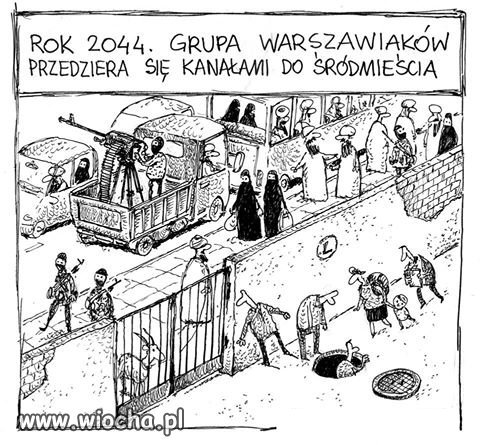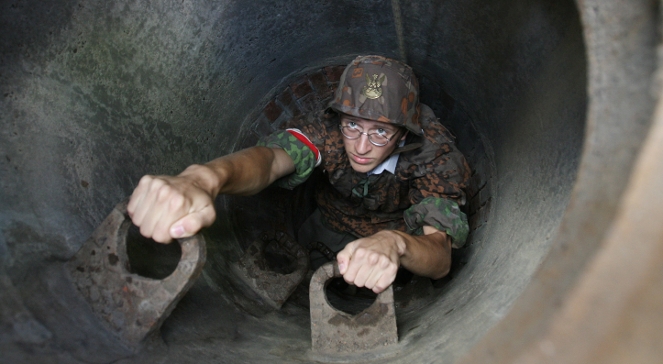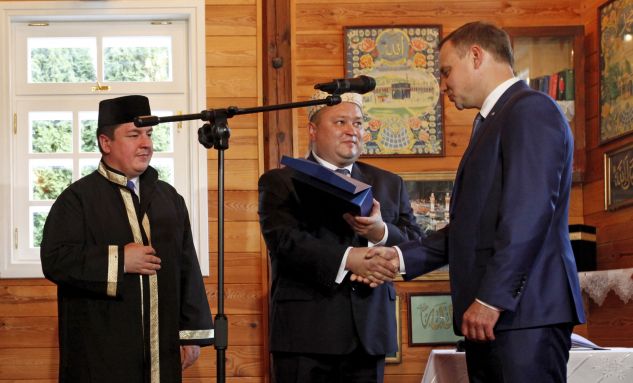|
|
Post by Bonobo on May 29, 2016 19:16:18 GMT 1
2044 - a group of Warsavians is breaking through city sewers to Downtown.(direct allusion to Warsaw Rising motif).   |
|
|
|
Post by pjotr on May 29, 2016 20:22:02 GMT 1
This would be funny if this cartoon depicted a Western-European city like Rotterdam, Brussels, Paris, Copenhagen, Stokholm, Malmö, Brixton or London with real problems with Muslim migrants, but Poland and Warsaw has very few Muslim migrants or expats and Poland has a very small Muslim community if you compare it to other Western nations like Great-Britain, the Netherlands, Belgium, France, Germany, Austria, Denmark, Sweden, Norway, the USA, Canada, Israel and Australia. Even Russia and Serbia have more Muslims and you could say they have an ethnic Muslim problem (in Russia with Chechens and other Muslim minorities, and in Serbia with ethnic Bosnians and Kosovar Albanians, who often attack Serbian border guards or Serbian Orthodox christians in Kosovo). Changes in recent yearsApart from the traditional Tatar communities, since the 1970s Poland has also been home to a small, and growing, immigrant and native convert Muslim community. In the 1970s and 1980s Poland attracted a number of students from many socialist-aligned Arabic-speaking states of the Middle East and Africa. Many of them decided to stay in Poland. In the late 1980s this community became more active and better organized. They have built mosques and praying houses in Warsaw, Białystok, Gdańsk (built by the Tatar community), Wrocław, Lublin and Poznań. There are also praying rooms in Bydgoszcz, Kraków, Łódź, Olsztyn, Katowice and Opole.[11] Since the overthrow of Communism in 1989, other Muslim immigrants have come to Poland. Relatively prominent groups are Turks and Muslims from the former Yugoslavia. There are also smaller groups of immigrants from Pakistan, Afghanistan, and from other countries, as well as a refugee community coming from Chechnya. The Polish Shia minority includes immigrants, foreign students, and embassy staff, mainly from countries such as Iraq, Iran, Bahrain, Lebanon and Pakistan, along with native converts to Islam. Currently, Shi'ites in the country do not have their own freestanding mosque, but they do meet for weekly Friday prayer and major Islamic holidays. The exact number of Muslims living is Poland remains unknown as the last all-national census held by the Central Statistical Office in 2011 did not ask for religion. ChallengesThere's an ongoing conflict between Polish native Sunni Muslim Lipka Tatars, who have a unique approach towards Islam and have been living in Poland for 600 years, and an increasingly vocal group of mainly foreign-born and foreign-sponsored, but also native-born convert, group of Sunni Muslims who adhere to Wahhabi movement. The conflict divides country's Sunni Muslims and causes bureaucratic confusion, as both sides lay claim to representation of country's Sunni Muslims. The " native born" Sunni Muslims ( Lipka Tatars), run Muzułmański Związek Religijny w Rzeczypospolitej Polskiej ( Muslim Religious Union in the Polish Republic), and " foreign born" Sunni Muslims run Liga Muzułmańska w Rzeczypospolitej Polskiej ( Muslim League in the Polish Republic). The latter is mainly based upon foreigners living in the coutry, such as Arabs, Pakistanis, Chechens etc. Liga Muzułmańska is also a branch of a worldwide Muslim Brotherhood organization.   Prezydent Andrzej Duda oraz mufti Muzułmańskiego Związku Religijnego w Rzeczypospolitej Polskiej Tomasz Miśkiewicz (L) i przewodniczący Zarządu Gminy Muzułmańskiej Bohoniki Maciej Szczęsnowicz (C) (fot. PAP/Artur Reszko) Prezydent Andrzej Duda oraz mufti Muzułmańskiego Związku Religijnego w Rzeczypospolitej Polskiej Tomasz Miśkiewicz (L) i przewodniczący Zarządu Gminy Muzułmańskiej Bohoniki Maciej Szczęsnowicz (C) (fot. PAP/Artur Reszko) |
|











